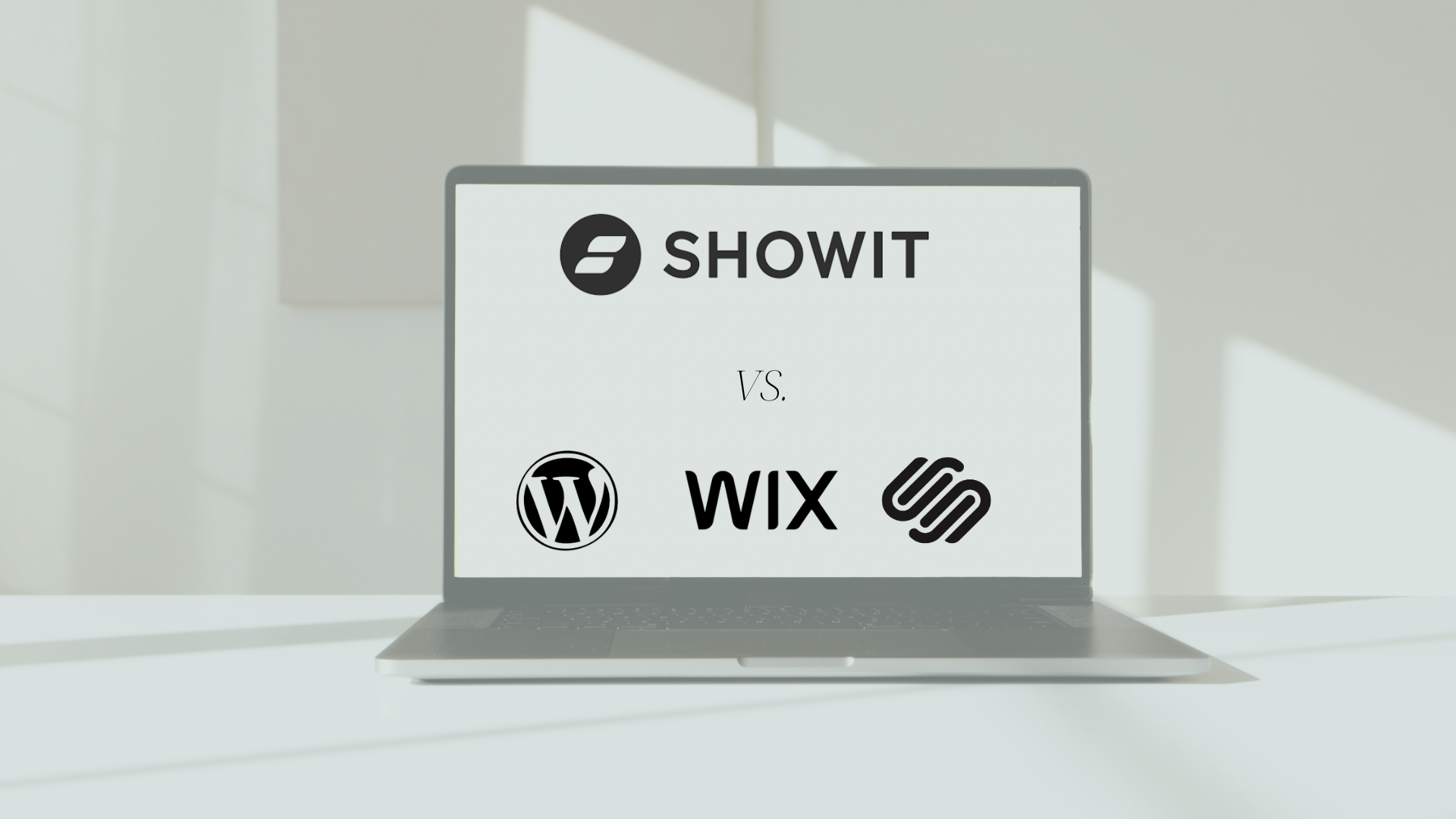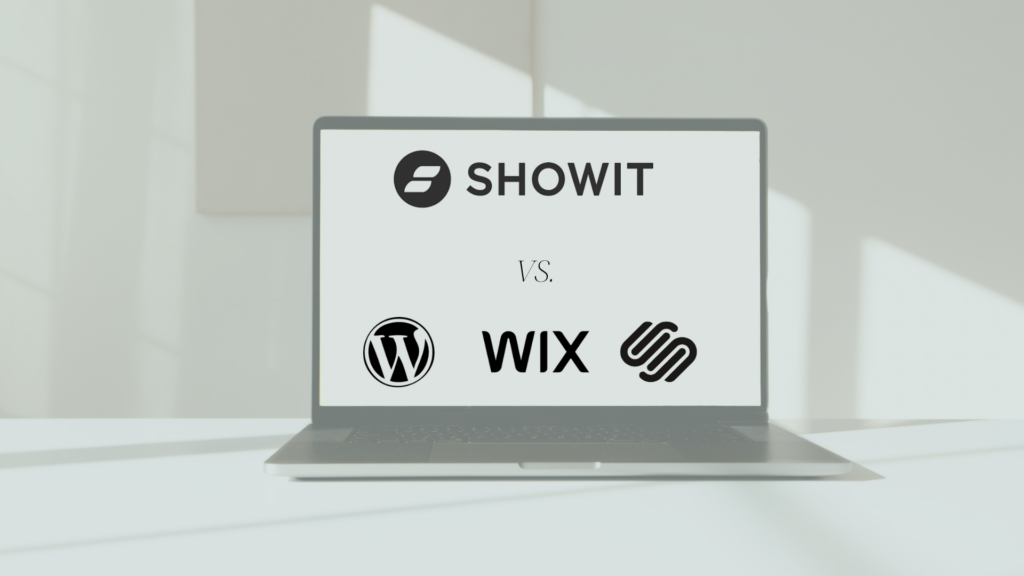What's the best website builder for your website?: Showit vs. Wix vs. Squarespace vs. WordPress: Choosing the Right Platform for Your Business Website


Disclaimer: This post may contain affiliate links, meaning I may get a commission if you decide to make a purchase through my links, at no cost to you. In fact, you often get a discount. Thank you for supporting my small business.
If you ask anyone in the online space what platform you should build your website on, you’re going to get some wildly differing opinions. Some people’s entire personalities are based on the answer to this question, and if you think you already have a preference, it’s wrong. (Friends, I’m being hyperbolic. Kind of.)
In this blog post, we will compare four popular website platforms: Showit, Squarespace, Wix, and WordPress, to help you make an informed decision for your next web design project.
I’ve designed on all three of these website platforms — they’re each great — and I appreciate them for different reasons. However, each individual is unique, and each business is unique, so one platform may be a better fit than others for each specific business.
1. Wix:
So, when I first decided to build a website, I had recently left my job driving cargo ships, bought a sailboat, and sailed around the east coast of the United States. I funded this through savings and by taking on small, seasonal captain gigs for extended periods. Fun? Yes. Conducive to the vagabond lifestyle I craved at the time? Not so much. When captaining, I was still tethered to a location, operating someone else’s boat for months on end, when I would have preferred to be sailing my own boat.
My solution: Start a sailing blog.
The problem? I didn’t know how to build a website or where to even start.
So, I asked my friend, Google, and one of the top search results turned out to be Wix. (I know now how important a strong SEO game is and appreciate that, if nothing else, Wix is optimized)
So, through some trial and error, I built my very first website on Wix. And since have managed client websites on Wix. Here are my thoughts.
Wix Pros
- all-in-one website builder that offers free plans, domain and website hosting, an integrated blog, online store capabilities, and booking, etc.
- Drag & Drop Editor: The Wix editor makes it easy to design your website
- Timely Updates: When it comes to updates on the editor, Wix is up with the times. Its AI chatbot in Wix Studio allows users to customize their websites to their needs without scouring the YouTube world for free tutorials, making the website builder fairly easy for the non-techy.
- Free Version: For business owners and creators on a budget, Wix has a free version so you can get your website online for free.
- Substantial App Library: Wix has compatible App Market (which are akin to WordPress Plugins), making it easy to expand your Wix website capabilities to include e-commerce shop, appointment, and class booking
- Built-in Analytics Tracking: Wix has website analytics tracking right in the dashboard, so you can monitor your website’s performance
Wix Cons
- Glitchy: The user-friendliness of a Wix builder tends to incorporate some code bloat, po making the website glitchy and slow…
- Free Version: Even though Wix offers a free version, your free Wix site (and its visitors!) will be subjected to Wix advertising. Plus, your domain will have .’wixsite.com’ at the end of it…not super professional if you’re building a website for your business
- Design Limitations: While you can get fairly custom with design and the drag and drop editor is clunky and some features require code to tweak it to exactly what you want.
2. WordPress:
My journey with WordPress began with a client who was struggling with her *cough cough Wix* website not having the exact capabilities she needed for her booking. The native app did not allow for simple customization of the payment processing language, and what she was stuck with didn’t make sense for the services she was offering, and it was killing her conversions.
A confused reader doesn’t buy, so within a year of launching her business, she had already outgrown the capabilities of her Wix website and needed a platform that was able to be more custom.
Enter WordPress.
WordPress is the most widely used content management system (CMS) globally, known for its flexibility and scalability. Created back in 2003 by developers Matt Mullenweg and Mike Little, WordPress is an open-source platform, meaning it’s able to utilize “plugins” created by other developers to enhance the site’s functionality. So you start with your base theme and customize from there.
Let’s explore its pros and cons:
WordPress Pros:
Complete Control: WordPress provides unparalleled control over your website’s design, functionality, and content.
Vast Plugin Ecosystem: As an open-source platform, the WordPress plugin ecosystem offers endless possibilities for adding features and functionality to your site.
SEO-Friendly: With the right plugins and optimization, WordPress can excel in search engine rankings.
WordPress Cons:
Learning Curve: WordPress has a steeper learning curve, particularly for beginners without coding experience. Many users find the backend overwhelming and are afraid to “break” the website.
Maintenance: It requires regular updates, security measures, and backups to ensure the site’s performance and security, some plugins require frequent updates or subscriptions to perform their function. There’s also the risk of
Design Consistency: Achieving consistent design can be challenging without a skilled designer’s help or paying for a drag & drop plug-in editor such as Elementor or Divi.
2. Squarespace:
Squarespace was my favorite website to build on when I began my freelance copywriting business. With its template options, I was able to launch a good-looking website quickly, and the backend of the site was really clean and user-friendly, having just come from building a WordPress website.
I even designed a couple of sites for my copywriting clients.
Squarespace is a well-established website builder known for its user-friendly interface and sleek templates. Here’s what you need to know:
Squarespace Pros:
Ease of Use: Squarespace is incredibly user-friendly, making it an excellent choice for beginners. The backend design is sleek, clean, and intuitive.
Beautiful Templates: It offers a wide range of professionally designed templates that are perfect for various industries. This means you have a designer-level structure to your website that you can simply plug your content into and boom, launch a good-looking website into the world.
Integrated E-commerce: Squarespace provides robust e-commerce capabilities, making it suitable for online stores (though if your business has multiple products with multiple SKUs, Shopify is your friend).
Squarespace Cons:
Design Limitations: While Squarespace offers attractive templates, customization options can be somewhat limited compared to Showit. I will say that the design for the websites I created using Squarepsace fell short of the original vision…but they still looked good.
Less Creative Freedom: If you have very specific design requirements, you might find Squarespace somewhat restrictive. In order to get true design customization, you need to know some code.
3. Showit:
Showit is the website builder platform that truly hooked me. I had dabbled in offering web design as a service, but my previous projects were more a byproduct of being a people-pleaser and problem-solver for my copywriting clients. But Showit? It unlocked a creative passion for building sites.
Showit is a relatively new but rapidly growing website builder known for its creative freedom and ease of use. Here are some key points to consider:
Showit Pros:
Drag-and-Drop Design: Showit offers a user-friendly drag-and-drop interface, making it easy for designers and clients to create custom layouts. It reminds me of using Adobe products like Illustrator or Photoshop.
Design Flexibility: It allows for complete creative freedom in design, allowing you to build unique and visually stunning websites.
Integration with WordPress: Showit allows you to integrate your design with WordPress for blogging capabilities while maintaining design control. Think unique, completely custom
Showit Cons:
Pricing: Showit can be more expensive than some alternatives, especially if you require advanced features or have tons of monthly views.
Slow to update: though super-duper flexible with design ability, Showit as a platform has been slow to roll out updates in comparison to the above platforms
Limited E-commerce: While Showit is great for portfolios and informational sites, it may not be the best choice for extensive e-commerce websites.
The choice between Showit, Squarespace, Wix and WordPress ultimately depends on your specific needs and preferences.
Overall, the best website builder for your small business is the one that you enjoy using. If you intend to maintain the website yourself rather than have a designer and developer maintain it for you, you want the website that you’re comfortable signing into, navigating the backend, able to update without “breaking” the website.
Showit excels in design flexibility, Squarespace in user-friendliness and accessibility, Wix in drag and drop features with the ability to add functionality through apps, and WordPress in control and scalability.
Want to give Showit a try? This link will give you one month free off your subscription.
Need a new website for your business? At Saltwater Heart Creative, I offer custom web design services and Website in a Week for up to 5 web pages. Click here to learn more.
Want to chat about it? Book a free consultation!
Shelagh Bajus
June 28, 2025
Saltwater Heart Creative is a web design studio based in New Hampshire and serving business owners and service providers worldwide.